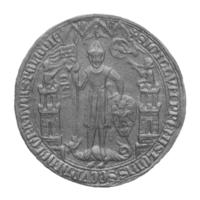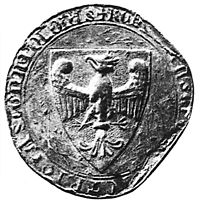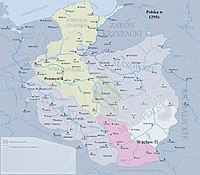Przemysł II
![]()
This article or subsequent section is not sufficiently supported by evidence (e.g., anecdotal evidence). Information without sufficient evidence may be removed in the near future. Please help Wikipedia by researching the information and adding good supporting evidence.
![]()
This article or section is still missing the following important information:
sources, literature and evidence for the credibility of all information
Help Wikipedia by researching and adding them.
Przemysł II (Polish Przemysł(aw), Latin Primislaus; * 14 October 1257 in Poznan; † 8 February 1296 in Rogoźno) was Duke of Greater Poland in Poznan from 1273. After the death of his uncle Bolesław, duke of Greater Poland in Kalisch, from 1279 duke of Greater Poland, from 1290 to 1291 duke of Lesser Poland in Kraków, by the latter senior duke (princeps) of Poland, from Christmas 1294 duke of Pomerelia, and from 1295, as Przemysław, king of Poland. He was descended from the Great Polish line of the Piast dynasty.

Seal of Przemysł II, which he had used in an Elbing document and in other Prussian documents.

Przemysław's royal seal with the crowned white eagle of the Piast; the coat of arms of Poland originated here

The political situation of the Polish duchies in 1295, and the dominion of King Przemysław (yellow).
Live
Przemysł was the only son of Duke Przemysł I and Elizabeth, daughter of Henry II, senior duke of Poland and duke of Silesia. Raised under the guardianship of his uncle Bolesław the Pious, he forced the surrender of his father's inheritance, the city of Posen, in mid-1273. In 1276 he formed an alliance with Duke Henry IV of Breslau, whom he unsuccessfully supported in 1277, together with Henry III of Glogau, in a conflict with Boleslaw II of Liegnitz. From 1281 he led border disputes with Henry IV of Breslau.
After the death of his uncle Boleslaw, in 1279, he ruled independently throughout Greater Poland. On February 15, 1282, he concluded a treaty with Duke Mestwin II of Pomerelia in Kępno, in which the latter recognized the feudal sovereignty of the Piast duke and transferred his dukedom - donatio inter vivos - to him. He strengthened his domestic power by putting down a noble uprising led by the Zaremba dynasty in 1285. In 1287 he countered the powerful position of the Margraviate of Brandenburg in the Neumark with an alliance with Duke Bogislaw IV of Pomerania-Wolgast (renewed in 1291). A year later, in 1288, an agreement was reached with his Silesian cousins, Dukes Henry IV and Henry III of Glogau, on mutual succession.
After the death of Duke Henry IV in 1290, he took possession of western Lesser Poland with Kraków (Duchy of Lesser Poland-Kraków), to which Duke Władysław I Ellenlang of Kujawy also laid claim and occupied eastern Lesser Poland with Sandomierz (Duchy of Lesser Poland-Sandomierz). In January 1291 he renounced Kraków in favour of the Bohemian king Wenceslas II, but retained the coronation insignia and in 1293 concluded an alliance with Władysław of Kujawy directed against Bohemia, on the basis of which the Kujawian duke took over most of his territories after the demise of the ally, in 1296 (although there was an older inheritance treaty with Henry IV of Breslau († 1290) and Henry III of Glogau († 1309)). After the death of Mestwin II, in 1294, he took possession of Pomerelia as part of the inheritance treaty. Brandenburg, which at this time consisted of two inwardly rivaling, outwardly co-operating lines, immediately asserted its own claims to the inheritance, from which flared up a war of succession which lasted for years, and which only found a conclusive end in the treaty of Soldin in 1309. Under the influence of the Archbishop of Gniezno, Jakub Świnka, Przemysław pursued the idea of uniting the Polish lands, which had been fragmented in particularism since 1138, and regaining the kingship. On 26 June 1295, with the permission of Pope Boniface VIII, he was crowned Polish king in Gniezno, ending the period of weak senior dukedom.
The renewal of the royal dignity in Poland after more than 200 years had great significance for the unification of the Kingdom of Poland, which was to last for 500 years, although he himself died already the year after his coronation. He died in 1296 as the victim of a kidnapping attempt instigated by the Margraves of Brandenburg (Otto V the Tall and John IV) in league with the local opposition (members of two noble families, the Zaremba and Nałęcz), who claimed Pomerelia and territories to the Neumark on the Nets. It is quite possible that King Wenceslas of Bohemia was in the background, who at that time counted large parts of southern Poland (Silesia, Lesser Poland) among his sphere of influence, and a kidnapping was originally planned to induce the prisoner to make concessions. Przemysław had an amicable relationship with the Church, maintained close contacts with townspeople, and especially patronized Poznan, where he is buried next to his ancestors in the cathedral. With him the Great Polish line of the Piasts, which had been founded by Mieszko III the Old, became extinct.
Wives
Przemysł was married three times, in first marriage from July 1273 with:
- Ludgarda (* c. 1260; † December 1283) daughter of Duke Henry of Mecklenburg;
in second marriage from 11 October 1285 with:
- Rixa/Rycheza (b. c. 1265; † before 1291) Daughter of King Waldemar of Sweden;
in third marriage from 1291 with:
- Margaret (* c. 1270; † 1315), daughter of Margrave Albrecht III of Brandenburg;
Search within the encyclopedia